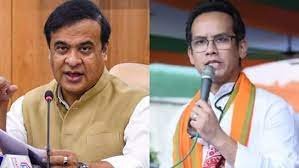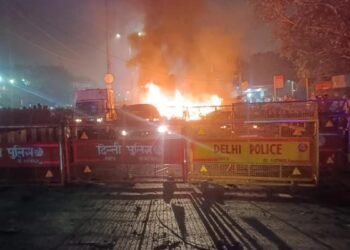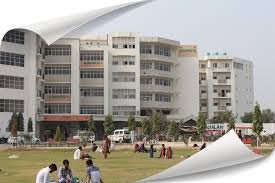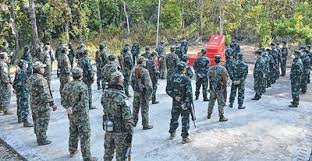Analysts say the CM’s communal messaging is aimed at consolidating Hindu votes amid growing dissatisfaction over governance, unemployment, and corruption.
By Navin Upadhya
November 13, 2025 — Assam’s political landscape is entering a volatile phase. As Chief Minister Himanta Biswa Sarma ramps up his rhetoric against Muslims — repeatedly invoking terms like “miya” in derogatory contexts and showcasing bulldozer actions against Bengali Muslim settlements — opposition parties have quietly forged one of the broadest anti-BJP alliances the state has seen in a decade. The two developments are not coincidental.
Eight opposition parties, led by the Congress under state president Gaurav Gogoi, announced on November 12 that they will contest the 2026 Assembly elections as a united front. The coalition includes the CPI(M), CPI, CPI(ML), Raijor Dal, Assam Jatiya Parishad (AJP), Jatiya Dal-Asom, and the All Party Hill Leaders Conference. Their stated goal: to “liberate the people of Assam from corruption, injustice, and administrative failure.”
This emerging unity — bridging ethnic, ideological, and regional divides — directly threatens the BJP’s dominance. Sarma’s escalating communal pitch appears aimed at deflecting that challenge by recasting politics around polarising identity lines, especially Hindu–Muslim faultlines that have historically shaped Assam’s social landscape.
The Desperation Behind the Rhetoric
Himanta Biswa Sarma, once a Congress strategist himself, has long mastered the art of identity politics. But in recent months, his speeches have grown sharper and more exclusionary. His frequent references to “Miyas” — a term historically used for Bengali-origin Muslims but now deployed pejoratively — signal a deliberate strategy: to consolidate Hindu Assamese voters and neutralise the growing disenchantment with the BJP’s governance record.
Political observers note that the BJP’s earlier plank of “development and stability” is losing its sheen. The state faces widespread unemployment, price rise, and disillusionment among youth, while repeated allegations of corruption and cronyism have dented the government’s credibility. The bulldozer-driven “evictions” of Muslim-majority settlements in Darrang, Nagaon, and Barpeta are thus being packaged as spectacles of strong governance — an attempt to convert administrative excess into political theatre.
In reality, many of these demolitions target poor families whose legal claims to land are entangled in bureaucratic disputes. By painting them as “illegal encroachers” or “infiltrators,” Sarma seeks to convert economic marginalisation into communal blame, diverting anger away from governance failures and toward a convenient scapegoat.
READ:
Together, we will overthrow Himanta Biswa Sharma’s government.
– Bhanwar Jitendra Singh jiThe Congress Party held a major meeting today regarding an alliance with the AJP, the Raijor Dal, and the Left parties for the upcoming Assam Assembly Elections pic.twitter.com/hY39KvnFfx
— Harmeet Kaur K (@iamharmeetK) November 12, 2025
Opposition Unity Upsets BJP’s Equation
The united opposition bloc marks a new phase in Assam’s politics. For the first time since 2016, Congress and key regional forces such as Raijor Dal and AJP — born out of the anti-CAA movement — are working together. Their coming together symbolises the mending of fissures that the BJP had exploited for years by portraying the Congress as “pro-Miya” and regional parties as “divided.”
By reviving a broad, secular, and issue-based alliance, Gaurav Gogoi and Akhil Gogoi have set the stage for a campaign centred on corruption, land rights, farmers’ distress, and unemployment — issues that cut across communities. For the BJP, this convergence is dangerous: it undermines the party’s tried-and-tested narrative of “us vs them.”
That may explain Sarma’s recent intensification of religious polarisation. Each communal remark — whether at a public rally or temple event — is part of a broader effort to frame the upcoming election not as a referendum on governance, but as a cultural battle for Assamese identity.
READ: DNA Confirms Red Fort Bomber as Kashmiri Doctor Umar Nabi
READ: Centre Adopting ‘Divide and Destroy’ Policy in Manipur: UNLF
The Bulldozer Politics of Fear
The chief minister’s frequent televised “eviction drives” in Muslim-dominated areas have become a central feature of his political messaging. These operations, often carried out with little warning, are accompanied by tough talk on “illegal migration” and “protection of indigenous land.”
However, critics argue that this bulldozer politics serves a dual purpose: projecting Sarma as a decisive, Hindutva-aligned leader in the Yogi Adityanath mould, while simultaneously instilling fear among minorities and polarising the electorate.
In many of these drives, Bengali-origin Muslims — some living in Assam for generations — bear the brunt. The imagery of bulldozers tearing down modest homes is powerful television for Sarma’s base, reinforcing the idea of a government “protecting Assamese land” from outsiders. But it also deepens Assam’s fragile communal fissures and risks alienating moderate voices even within the BJP’s support base.
A Battle Between Identity and Accountability
As Assam heads toward the 2026 polls, the contours of the contest are becoming clear: a battle between identity and accountability. On one side stands a chief minister seeking to harden communal lines to preserve his political dominance. On the other is an emerging alliance striving to redirect public attention toward livelihoods, corruption, and governance.
Sarma’s escalating communal tone reveals both his political shrewdness and insecurity. With the opposition finally uniting and discontent simmering beneath the surface, he appears intent on transforming Assam’s election into a referendum on religion rather than performance.
Whether the electorate will fall for this familiar playbook — or demand a more inclusive vision of Assamese identity — will define not only the 2026 election but the direction of Assam’s democracy itself.












